-
Content Count
2778 -
Joined
-
Last visited
-
Days Won
87 -
Feedback
0%
Posts posted by flip12
-
-
2 hours ago, PBH said:You can, but I have seen a few times where the holder gets warped if the oven is too hot or if you leave them in too long. Better to just wait until you have steel. Not like you are going to be skating on the boot without any steel. Right?
But the holders won’t be going in the oven at all, if I’m understanding correctly, only the boots will.
-
21 hours ago, boo10 said:My Micron Mega 10-90 skates had that notch, and I think it's a big reason why they were so comfortable to skate in.
I haven't seen the same feature I'm thinking of in Microns. I know they had the notch cut out between the third and fourth eyelets. I'm pretty sure every brand has tried that, though most stopped before Micron featured it. The Graf flex zone I'm referring to isn't actually a notch, but an extra space between the top and second eyelets on many Graf models. Graf's usually-lower boot height makes this roughly a spacing between the second and third eyelets on more traditionally cut boots. It's sort of a forced eyelet skip, though not as big of a jump as a full eyelet skip, promoting forward flex. CCM started having more space there in the second gen. JetSpeed, if I recall correctly. Now Bauer's doing it and emphasizing it the same way Mission did 15+ years ago.
-
Clever. Another Graf detail incorporated by the other brands. CCM had that gap there first, going a few generations back. Now Bauer's got it and throwing in the flex dart for emphasis.
-
 1
1
-
-
2 hours ago, decoy said:Click to enlarge (image size 3858x2572)
Also looks like there’s a Missionesque flex notch between the 2nd and 3rd eyelets at the top.
-
 1
1
-
-
5 hours ago, Westside said:That’s a lot of yellow accents…
...

-
 1
1
-
-
11 hours ago, Fat Buzz said:When I wanted my new logo, I got on Freelancer and hosted a contest for logo design. I set the winner to receive $25, told them a description of what I was looking for... and tons of graphic designers (from countries that think $25 USD is a big deal) really competed for it. A couple weeks later I picked a winner from all the submissions, and I ended up with the best logo in my league.
Let’s see it!
-
 3
3
-
-
Happy to help! I was actually sitting and doing some design sketches when I came across this topic.
-
 1
1
-
-
Just sketched this up. Nothing revolutionary, but it's pretty true to the original.

-
 3
3
-
 1
1
-
-
Why don’t they just sew them to the boot?
-
5 hours ago, Vet88 said:In his early days he did but later on his career he played with just the bottom 5 laced (rules are that you must have laces and must have them tied). He played in AllStar games with no laces, the tongue flop was ridiculous.
Can you post some pictures of him playing with 5 eyelets laced? That's worth seeing.
All-Star games? At what level?
-
5 hours ago, Vet88 said:Where it seems to become a hinderance? What do you base this on other than your own personal experience of lacing up tight in a stiff boot? How about Darryl Evans who played games in the NHL with only the bottom 5 eyelets laced up. Or European ice hockey teams training with laces untied. You seem to forget that since humans started skating on ice - bar the introduction of composites - skates had next to 0 ankle support. Skaters did just fine with very little ankle support doing everything you seem to think they couldn't.
Didn’t Evans tape his tendon guard, tongue and upper eyelets in a bundle like Orr?
-
19 hours ago, Sniper9 said:The catalyst just looks like a diff skin. I bet they are gonna say it's lighter carbon but the toe cap etc looks the same just diff graphics. But to be fair true's success is from their fit. Can't really mess with the design without messing with the fit.
It looks like the TF goalie skates, just with different graphics and a tendon guard. The toe cap and quarter pieces all look very similar to the branding and shell-covering scheme as the TF goal skates.
-
 1
1
-
-
30 minutes ago, psulion22 said:Manufacturers have been trying to shave grams off of the runner weight for decades, just like they've been trying to do to all the equipment. They switched the holders from metal to plastic. Then they added holes to them. Then they added holes to the steel runners. T Blades made a runner that was a smaller piece of metal and a lrger plastic holder. Bauer tried fusing aluminum to the steel. Now they're trying that with carbon fiber.
If there was no tangible benefit, skate manufacturers wouldn't have been trying to cut weight essentially since they started making skates. I agree that the redution of even 35% of the weight of a runner, which results in just a few grams, is likely not going to make anyone faster or better when taken as a weight savings. However, there are two reasons I can think of that would actually make a difference and cause an improvement in performance.
The first is overall weight distribution and balance. These runners are being included on Bauer's flagship skates. Those skates are incredibly light overall. Changing the distribution of the weight by even a few grams could make a pretty big difference to how the skates feel to the player. Reducing the amount of weight underneath the foot would likely improve the feeling the skater has with the ice. CCM has gone to one piece boots, not just to cut overall weight, but to eliminate the midsole and the weight under the foot as a result. As an example of this, forget the weight of composite vs wood sticks where the difference is huge, but look at how changing just a few grams here or there can result in a composite stick that feels too blade heavy, or not blade heavy enough to give good puck feel. Look at how adding one or two grams of lead tape to a golf clubs changes the swing weight and performance.
Second is playing off T Blades design, and goes along with the development of countless methods of reducing drag like blade profiles, FBV, Z Channel, Flare blades, and many others. Skating creates friction between the metal blade and the ice. That friction heats the metal and causes surface melting, that melting is what allows us to glide on the ice. When skates are too sharp, the edges penetrate the surface melt and dig, reducing glide. By reducing the amount of metal in the runner, you also reduce the mass of the blade. Reducing the mass of the blade allows it to heat faster and higher, causing more surface melt, and increasing glide. An increase in glide and a reduction of drag could increase overall speed, manueverability, efficiency, and endurance, far more than the simple reduction in weight of a few grams could. Plus, less metal likely means less rigidity, and more flex on the blade. That flex creates more energy return, acceleration, and stopping efficiency (part of the theory behind Bladetech runners).
Wouldn't more surface melt mean more drag? Comparing to faster ice being ice that's colder, with less of a liquid (pseudo?)layer.
-
I find it much easier to sprint in my MLX boots that are ~ 70 grams lighter than my classic Grafs, even though I find the flex profile of the Grafs more natural. It sounds dumb it's so simple, but my feet definitely feel significantly lighter in the MLX.
-
48 minutes ago, stick9 said:Curious why Bauer choose to fuse the two parts. Why not make the carbon fiber part a spacer for a new lower height runner. That way the steel is replaceable after it's worn.
Also curious as to why they haven't tried titanium. Too brittle...too hard to sharpen? There has to be more to it than just cost.
First paragraph, how would that work? Would it require a new holder or steel cross section?
Second paragraph, weren’t Ti runners used in the 90’s? What’s the story with those?
Another note in general, on the mass reduction compared to other steel options, at least A/B testing is as simple as swapping out steel. You could test everything, blind ideally. One CarbLite blade in one holder and something else in the other. Then opposite sides, one full set then the other. It would be interesting to see how perceptible the difference is, or if the feel is comparable, etc.
-
1 hour ago, mhein22 said:thats an irrelevant example. boxing gloves are hanging off the ends of your arms. the glove has leverage. you are talking about a 60% weight increase. the punching motion is literally trying to throw that glove forward.
when you are skating, you have 200lbs extended out over 6 feet away from your skate that your one leg is trying to push. often times that 200 lbs has inertia so theres even more pounds of force at work against your leg. at least one skate blade is on the ground at all times. so you are talking about 200 pounds your moving, plus whatever is added by inertia forces and the leverage over 6 feet, and youre talking about an ounce or two hanging 6" off the ice and you think that makes any difference at all to your skating or stamina. it absolutely does not.
if we are talking about a stick, of course the lightness makes a difference! its 5 feet long and often you are manipulating it with just your wrist or forearm. theres so much leverage involved there that the lightness makes a difference. but a skate blade is hanging under your foot. it has no leverage. its a fraction of a percent of weight decrease.
if you put that on a blind test, i guarantee the results would come back as no discernible difference in skating or stamina. and you are wearing runners that cost you a bunch of money and snap on you and send you into the boards. its not good.
Nitpicking here, but one skate blade on the ice most of the time, not all of the time. The fastest skaters incorporate some jump between strides when they can. I think that's one major differentiator in acceleration performance.
-
4 hours ago, marka said:Howdy,
So... struggling to get a good heel lock on the TF7s. Its not horrible, but I can feel my foot lifting up/down a bit. If I tighten laces enough that my foot is locked in, my arches start to hurt.
Thinking I should rebake.
I can get the plastic wrap. My understanding is that the procedure is to lace up through the forefoot/arc and leave the top 3/4 eyelets undone, with packing wrap around the ankle area. Can I expect that to tighten up the heel, or should I be looking for a way to apply more pressure from the sides? I could probably rig up a clamp against some boards with foam between the boards and the boot...
Anyone have the heating instructions for home baking for TF-7's?
MarkI've struggled with heel lock in my MLX in the past, and when I tried to really kick my heels in on rebakes, it made a huge difference. The best heel lock I got came from three focus points for me:
1. Kicking my heel in really well, as previously mentioned. The heel of SVH boots is so cavernous and the Achilles area so pliable that it just feels nice when you bake it and it's easy to miss the importance of this step to really drive the fit home there. You really want to get a snug connection between the boot and the foot above the calcaneus. Failing to drive your foot far enough back will kill this.
2. Lacing snug, without overdoing it, from the bottom eyelets by the toe box all the way up to but excluding the third eyelet from the top. I didn't lace or wrap the top with plastic wrap but that's because I like a good deal of eversion in my stride and wrapping the firm facing and quarters prevents that rotation.
3. Massaging the outside of the boot above the heel to promote secure fit around the Achilles.
-
 1
1
-
-
On 9/10/2021 at 1:48 PM, sweed said:Those are the ones that I would prefer. I guess it all depends on how soft you want the skates to be.
When compared to more modern skates, these are really soft and low cut.
I don't jive with modern skates. The best I've found are MLX, which are just as low cut as my 703s but so much stiffer in the facing that it's hard to get the right balance of feel for the boot and range of motion. 703s just work for me. I just got sucked down this rabbit hole of trying to stuff my feet into the smallest boot I could stand in search of "performance fit," but so far, it seems to just stunt my stride to not have a little wiggle room for the foot to expand on landing and push. I'll give my very snug 703s a few more tries and if they're a no go, I think I'll spring for the F60s, even if I'm a little suspicious of the finer details now. The picture shows Clarino, but the description says Airnet. I think I'll get an actual photo instead of the stock one before buying, just to make sure it's not going to be a blob tongue and tendon guard fiasco.
On 9/11/2021 at 11:28 PM, swede said:Cant tell for sure, BUT the F60’s will probably be a lot better than the G35x… The G35x’s were one of the Canadian graf skate models that had severe quality problems, while the F60 is a Swiss made Graf 704 with modern materials..
That's the perfect way to sum it up. The G35s feel like a good imitation of a Graf skate, but without the actual soul and appreciation of what makes Graf Graf. You had me convinced on your last 11 words. I just have plenty of skates from all of my research and experimentation and would be thrilled to find something that works in my arsenal if I have it already.
-
Looks like CXN mated with a DriveShaft holder.
-
No idea. I do like the look of the holder, not too fussy. That’s all I’ve seen of them, from another topic here where the OP was looking for replacement steel.
-
-
28 minutes ago, sweed said:The F60 I´ve seen in the past had the same cut/boot as the 703/704. They also had pretty much the same felt tongue as the old ones but I think they have been released with that short, thick, black, hideous tongue as well at some point.
The other thing that (I felt) didn´t seem as nice on the F60 were the black airnet-liner and it also seemed to have less padding around the ankle and forefoot.
This is definitely the 703/4 pattern F60. I've seen a few versions with minor variations. The details you mention are fortunately not what it looks like these have. This is the version I'm considering:

Classic felt tongue, grey clarino liner, and traditional 703 tendon guard shape rather than the fat star like Komarov had on his F60s.
If these avoid the stiffness overload that killed the wrap on the G35Xs, I'd be happy. My G35s had the airnet liner (ok but not as nice as Clarino, and the padding seemed 2nd rate compared to what Graf used before) and fat star tendon guard but came with a decent felt tongue. They'd work ok, but I bought them a little small, thinking I was getting "performance fit," but that didn't work out.
-
Hey. I'm looking at getting a pair of Graf F60s before something with the classic 703 fit is hard to find, custom only, or worse. Can anyone share experiences on how these compare in stiffness and feel to 703s?
I had a pair of G35Xs (tech-mesh nylon quarters) that were so stiff in the facing that they didn't wrap nicely like Grafs normally do. If the flex profile of the F60 is similar to the 703, I might not be able to pass it up.
-
I'm interested to see that video.
There is a major difference in anchor points between flex testing at the factory and flex in use.
The testing setup looks like if you held out your arms in front of you, put the stick on your forearms and had a buddy push down on the shaft beneath your nose until it flexed 1". This would likely leave nasty bruises on all flesh involved, so don't try this at home.
The actual impression of flex in use is how hard it feels to flex the stick when you hold it at the top, press it into the ice at the bottom and apply the load force somewhere in between those two points. Those distances change with cutting, plugging, and hand position, which affects the force equation.
If you take a cut stick and an uncut stick and they're the same flex rating, they should perform the same in the factory test unless you cut so much off that the force position has to change. There was that interesting variable flex testing done on all the current sticks about 5-6 years ago that showed how much easier or harder it was to flex the same stick in different zones.
That's my best guess.



TRUE TF9/TF7 skates
in Ice Hockey Equipment
Posted · Report reply
TF9 is top of the line, but True isn’t really feature oriented in that way. In my opinion, the features in new generations of skates are mostly there to justify changing to a new model year. True’s emphasis seems to line up with this. The core of what they do is incredibly solid and they prefer to tweak that to keep the focus on fit and function over making false promises about how a boot will make you faster. TF was their first line of ready to buy skates and the marketing focus was on how they were able to make a new shell to allow similar fit and performance from their custom offering at retail and an incredibly hard to refuse price point.